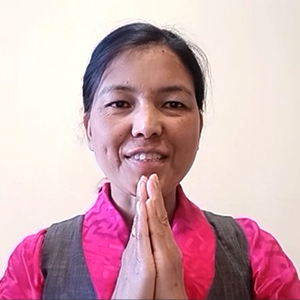TIBETAN LANGUAGE COURSES
Our Tibetan language courses can be taken alone, without attending the Summer Institute. If you attend the Summer Institute, these courses are included in your tuition.
All Tibetan classes will be transmitted live via Zoom and recorded for viewing asynchronously through our Online Campus (Moodle). Tibetan language course recordings will be available until October 4, 2023.
To register for the complete Summer Institute please click here.
Beginning Colloquial Tibetan
July 6 – August 2, 2024
FACULTY

NIMA BHUTI

GERRY WIENER
Prerequisites: None
This class is oriented toward students who have no experience or little experience with colloquial Tibetan. During the Summer Institute, we will introduce the eight categories of Tibetan letters, how to spell Tibetan words aloud, how to pronounce Tibetan letters and words, and how to read and write Tibetan. We will also introduce some useful phrases and sentences.
The Eight Categories of Tibetan Letters
- Thirty Consonants
- Four Vowels
- Ten suffixes
- Five prefixes
- Two sub-suffixes
- Superscribed Letters
- Subscribed Letters
- Punctuation
On learning these eight categories of Tibetan letters, students will be able to read Tibetan texts aloud with correct pronunciation.
Intermediate Colloquial Tibetan
(continuation)
July 6 – August 2, 2024
Also taught by Nima Bhuti and Gerry Wiener, this course is for those students who already have some established grounding in colloquial Tibetan. The focus will be to gain further fluency in reading, speaking, listening, and understanding Tibetan using the Central Tibetan dialect. Classes are mostly in Tibetan with minimal English.
Required Texts:
Speak Fluent Tibetan by Dr. Chok Tenzin Monlam Peltsok (Google Books)
Speak Tibetan the Tibetan Way by Nyima Dekyi (Google Books)
Prerequisites:
Students should know:
- The equivalent of the first 35 chapters of Speak Fluent Tibetan and Speak Tibetan the Tibetan Way.
- What the essential and existential verbs are and how they are used (yin, min, red, ma red, yod, med, ‘dug, mi ‘dug, yod red, yod ma red)
- Demonstrative pronouns (‘di, de, pha-gi, ya-gi and ma-gi etc.)
- Personal pronouns (nga, khyed-rang and khong etc.)
- Volitional and non-volitional verbs
- Transitive and intransitive verbs
- Verb tenses (past, present, and future) and auxiliary verbs
- Basics of locative, genitive, and instrumental cases
- Some understanding of the difference between honorific and non-honorific words and when to use them
- How to read somewhat more complex Tibetan sentences aloud (but not necessarily understand their entire meaning)
Reading Tibetan Buddhist Literature
(intermediate)
July 6 – August 2, 2024
FACULTY

MARK SEIBOLD
Prerequisites: Instructor’s permission is required for new students. Please contact mseibold@nitarthainstitute.org to check your level.